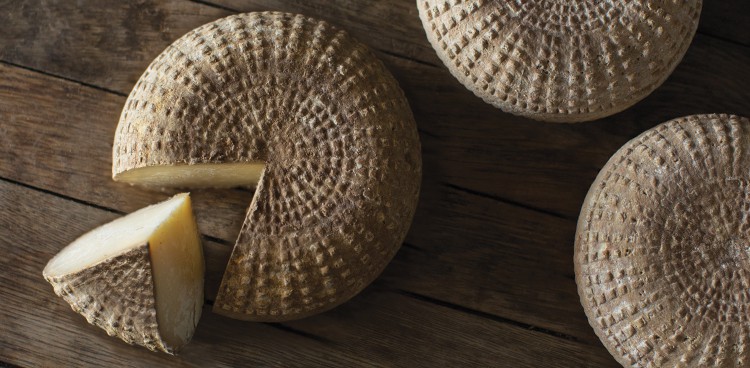
“It was love at first sight—I’d never seen a cheese like that before,” Philadelphia artist Mike Geno says. He’s referring to Rosa Maria, the Spanish-style aged goat cheese from Dutch Girl Creamery that stopped him in his tracks at the 2014 American Cheese Society conference in Sacramento, Calif. With a gorgeously mottled exterior reminiscent of a sea urchin shell, “it’s a classic beauty,” says Geno, who has painted more than 250 cheeses.
He asked cheesemaker Charuth Van Beuzekom to ship him a wheel. Only after completing the portrait did Geno, who was attempting to paint one cheese from every US state, realize that award-winning Rosa Maria put Nebraska on his map, much like Van Beuzekom and her Dutch Girl Creamery are helping to put the Plains state on the country’s cheesemaking radar.
Sowing Seeds
But there’s more to Rosa Maria than good looks. The story of the salt-brined stunner begins across the ocean. Though Van Beuzekom was born in Rosas, Spain, she only lived there a year before moving to Holland. She remembers visiting her grandfather’s idyllic house in Reeuwijk, where they’d pick vegetables and smoke fish, then stop by neighboring farms to select eggs and dairy for the week.

Dutch Girl Creamery’s Charuth Van Beuzekom standing in the pasture with her Welsh corgi, Penny.
“I loved the smell of cheese aging on wooden shelves and tasting every batch,” Van Beuzekom says. “At age 5, my first real conviction was that I would be a farmer when I grew up.”
When she was 6 years old, Van Beuzekom’s family moved to the US, settling in Mendocino, Calif. At age 9, she received her first goat—a Toggenburg named Pennyroyal, a present from her mom—and started making fresh cheeses studded with herbs from the milk. Later, Van Beuzekom headed to the University of California, Santa Cruz, and while earning a biology degree she met her future husband, Kevin Loth, who was pursuing agroecology and environmental studies. Shortly after graduation, the pair decided to start a family and a farm. In 1996 they purchased 34 acres just outside of Lincoln city limits in Nebraska, Loth’s home state, and began growing organic produce. Shadow Brook Farm was born.
To add value to their business and fulfill Van Beuzekom’s livestock dreams, they bought a small goatherd in 2006 and founded Dutch Girl Creamery. Van Beuzekom partnered with another up-and-coming local cheesemaker—Krista Dittman of Branched Oak Farm in Raymond, Neb.—and the two women secured grants to take classes and visit 27 cheesemakers in five states and four countries.
This led them to the Pennsylvania Association for Sustainable Agriculture conference, where Van Beuzekom met star New York monger Anne Saxelby, who mentioned a scarcity in the cheese market: hard, aged goat cheese. That comment, along with Van Beuzekom’s desire to create a goat’s milk riff on Manchego, inspired Rosa Maria. “I wanted to [make] something like a pecorino: a hard, grating-style cheese but Spanish-y,” she says.
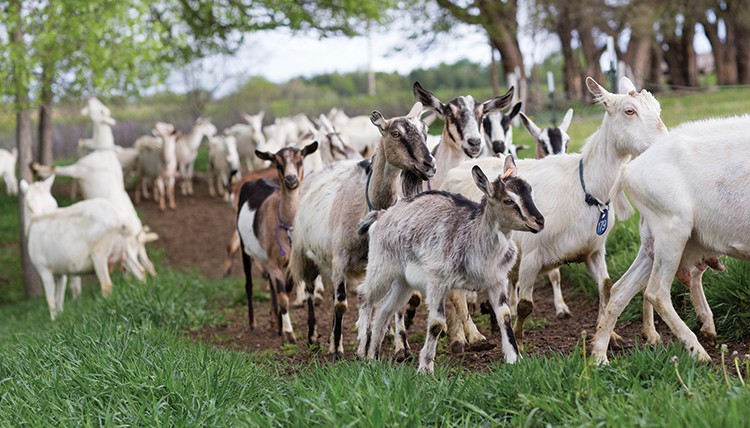
Crafting in Color
This year, Dutch Girl Creamery will milk 130 Alpine and Saanen goats (their 150-strong herd includes a Nubian buck that Van Beuzekom added to the mix two years ago to boost butterfat). The animals graze rotationally on alfalfa fields bursting with orchard grass, brome, chicory, and clover.
“Chicory blooms blue, and with the purple of the alfalfa there are times when our pastures are just aglow with blue and purple flowers,” she says. “I like to think it’s affecting the flavor of our cheese because it smells so beautiful out there.”
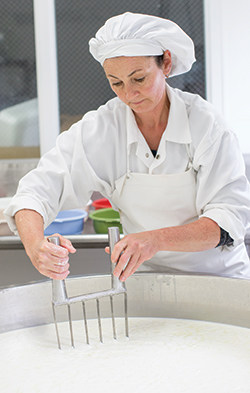
Charuth Van Beuzekom cuts the curds for Rosa Maria (the colorful forms used to make the cheese are seen in the background).
The creamery produces 20,000 pounds of cheese annually and about 20 percent of that is Rosa Maria, made from pasteurized spring and fall milk, which is rich in fat and solids. This seasonal milk, plus a blend of thermophilic and mesophilic cultures—formulated by Van Beuzekom with assistance from Margaret Peters-Morris of Glengarry Fine Cheese—help produce the desired texture: A paste that may be grated but that’s supple enough to eat solo.
Curds are heated, stirred, and pressed into rainbow-bright forms—gifts from famed British cheesemaker Mary Holbrook, whom Van Beuzekom met during a stint working at Neal’s Yard Dairy during the 2010 holiday season. “It’s really fun when you see them all stacked up—these vintage vegetable colanders in great ’60s colors,” says Abigael Birrell, who helped Van Beuzekom make cheese in 2014 and 2015 and now helms the fledgling Hub Cafe in Lincoln. “It’s a much more colorful process than you often get in a sterile cheese room.”
The cheeses are lifted out of the vat and set aside to rest for an hour before a single flip. Rounds are brined 18 to 24 hours, dried on wooden boards for a couple of days, and transferred to an aging cave where they are dry-brushed and flipped occasionally for at least four months (though often longer).
The resulting four-pound cheeses are floral and earthy with tangy notes, encased in dimpled, gray-brown natural rinds. Paul Kulik, chef and owner of Le Bouillon and executive chef of the Boiler Room, both in Omaha, calls Rosa Maria the “consummate goat’s milk grating cheese—it has the perfect seasoning effect.” Shredded over salad or pasta “it’s tart umami,” he says. “You get little bursts of nuttiness…a bit of mushroom.”
Bryce Coulton, chef and co-owner of The French Bulldog, also in Omaha, serves Rosa Maria on his house-cured charcuterie platters. [Editors note: the restaurant closed April 16, 2016.] If he receives a wheel on Friday or Saturday, it won’t make it to Wednesday. People appreciate it, he says, “not just because it’s local, but because it’s of exceptional quality. There’s character to it.”
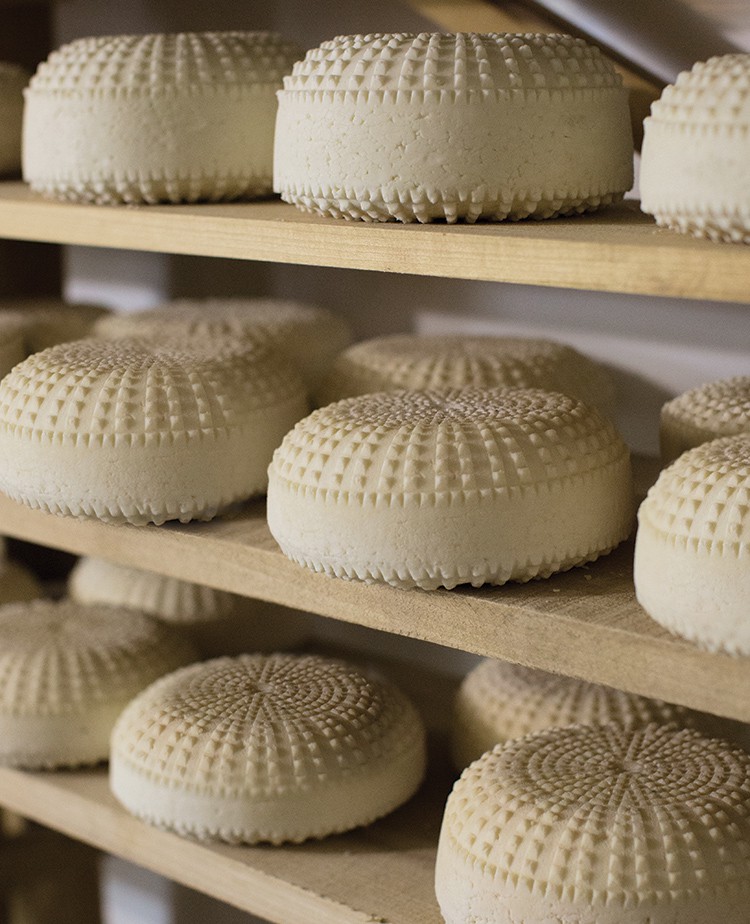
Spreading the Curd
Van Beuzekom started hawking her cheeses (seven styles plus some seasonal offerings) alongside Shadow Brook Farm–grown veggies and flowers at farmers’ markets. Now she’s focused on selling wheels to chefs in Omaha and Lincoln, both fast becoming culinary hotspots. And since Rosa Maria’s first-in-category win at the 2015 American Cheese Society Judging & Competition, the cheesemaker has received inquiries from restaurants and shops farther afield. While she’s not seeking national distribution right now—“our production’s not big enough,” she explains—Van Beuzekom hopes to extend Dutch Girl Creamery’s reach in the Midwest.
In 2013, Van Beuzekom and her husband finished constructing a 1,400-square-foot cheesemaking facility. Partially funded through Kickstarter and attached to the Shadow Brook Farm store, it encompasses three aging spaces. As Van Beuzekom plans to milk 200 goats in 2017 to keep up with demand, the couple may need to build a second barn (they’re in the process of expanding Dutch Girl’s current milking parlor, located in a 100-year-old barn). Another dream is to open a tasting room for visitors to the property.
All of these improvements, along with courses and continuing education, have helped Van Beuzekom hone her craft over the years. Striking Rosa Maria, now immortalized in a Mike Geno oil painting, was her first cheese and is named after Rosas, Spain (her birthplace), and Maria (her middle name). “That’s why I was so excited this cheese won [at ACS],” she says. “In a way, it truly is my baby.”
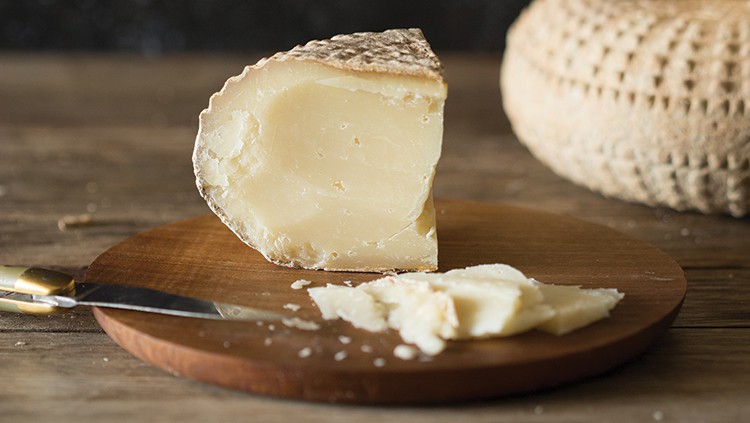
Pairing Suggestions
Cheesemaker Charuth Van Beuzekom prefers the cheese sliced, served simply with a tart apple (try McIntosh, Empire, or Pippin varieties) and crusty bread.
Chef Abigael Birrell of Lincoln’s Hub Cafe, meanwhile, matches Rosa Maria with French sauvignon blanc or Provençal-style rosé. She saves younger wheels for cheese plates because there are “so many fresh flavors in it,” Birrell says, but shaves mature rounds into sunchoke salads.
photographed by Dana Damewood



